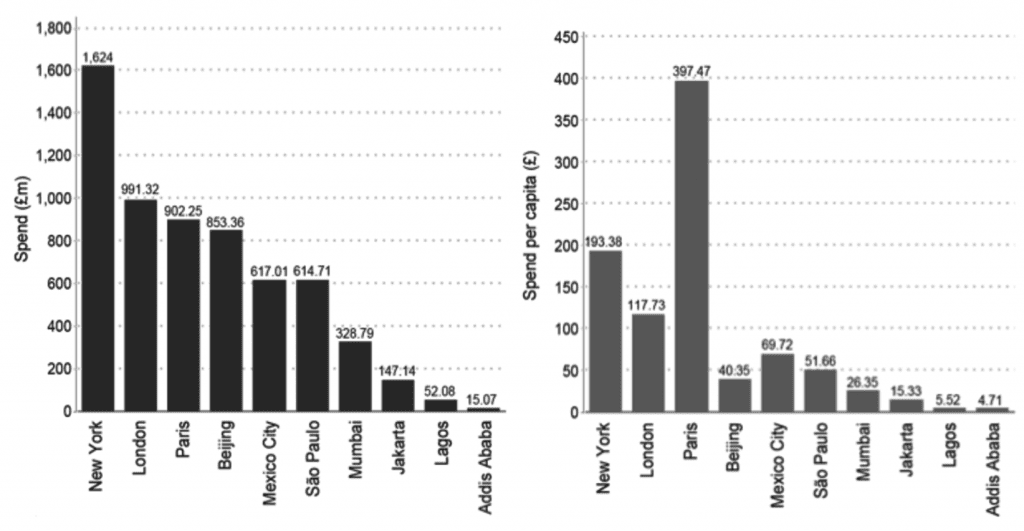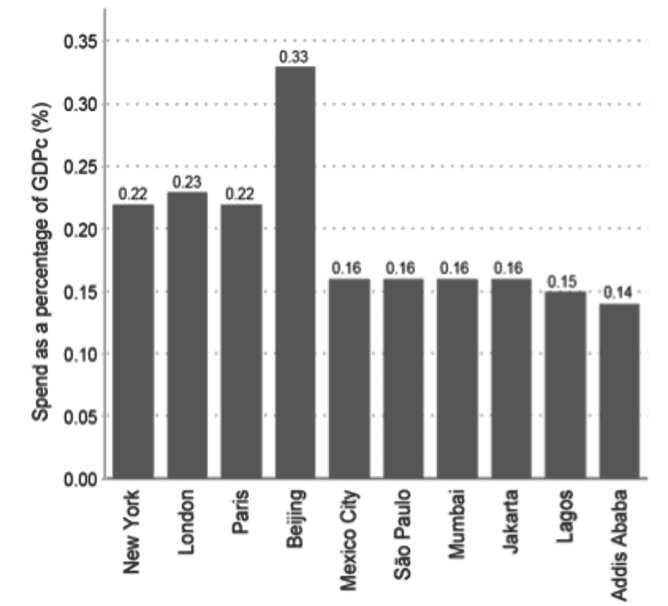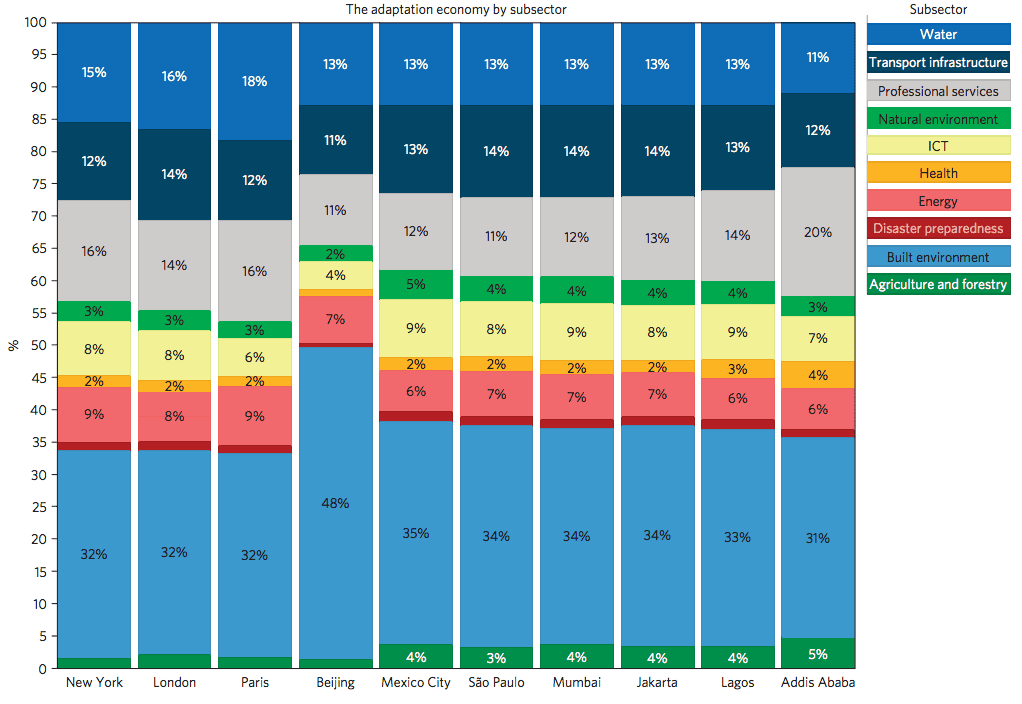A research team from University College in London has calculated that in the last five years, the ten biggest cities have increased their climate adaptation spending by a quarter. But they also found that it’s capital, not people, that we’re investing the most to protect. Beyond the moral implications this entails, it also means that poor but highly populated cities and their people remain vulnerable.
More than half of the human population lives in cities, and expected to increase to 66% by 2050. Their size, complexity and sheer number of inhabitants however puts cities at risk from climate change — from rising sea levels in coastal cities to heat waves or droughts in densely packed population centers. People living in extreme poverty are especially vulnerable, as developing countries will suffer the brunt of the effects of global warming while having the least monetary resources to protect themselves.
With this in mind, a new study from the University College in London comes to look at how the ten largest megacities across the world are responding to the threat of climate change and if resources are allocated efficiently and fairly. Adaptation spending figures were gathered from over 1,000 sources and analyzed through data triangulation, a method which draws on many different sources and types of data to produce more accurate estimates.
“We started with an overall definition including all economic activities related to adaptation across the ten economic sectors in the study, says lead author Dr. Lucien Georgeson in an interview.
“From there, we isolated the activities that could be directly related to climate change.”
Climate adaptation is an umbrella term that includes any and all steps taken to anticipate the negative effects of climate change; this includes effects on human health, economies and ecosystems. Has your city been extra environmentaly recently? Or if you live somewhere close to the coast, have the sea walls gotten bigger since this whole “global warming” thing? That’s climate adaptation spending at work.
“Building the Thames Barrier was to protect against weather events, particularly storm surges…That cost would not be counted as an adaptation to climate change, says professor Mark Maslin.
“However, the Environment Agency has planned to retrofit it to increase the actual gate height by an extra meter. This is a clear adaptation to increased sea level rise in the future.”
The numbers
Wherever the team looked, spending remains a teeny tiny part of the economy, peaking at 0.33% of GDP, a solid 25% increase over the last five years.

Image provided by author, Georgeson et al/Nature Comms.
But developed cities spend a lot more money for the cause in total and per person than developing ones. New York for example shells out more than US$260 per capita on adaptation, while Ethiopia’s capital Addis Ababa spends less than US$7.
“We were expecting there to be disparity between developing, emerging and developed countries, Maslin said in an interview for Carbon Brief.
“However, what we weren’t expecting was for the difference between, say, Lagos and New York to be a 35-times increase in spend to protect the population against climate change.”
Developed cities also spend more as a percentage of city GDP — meaning that a larger chunk of the city’s finances are invested in climate adaptation.

Image provided by author, Georgeson et al / Nature Comms.
The three richest cities on the chart spend almost one and a half as much as developing cities — 0.22 percent compared to 0.15 percent of GDP. Developing countries understandably have a lot more competition for their expenditure, things like clean running water or basic healthcare systems. But they’re also the ones who will feel the effects of global warming the most. This resource gap is what the authors call a “proof of concept” that money is being spent to protect physical capital, not people.
“You might expect that cities like New York are spending a lot more on climate change adaptation. But the fact that they’re spending more as a percentage of their GDP and much more per capita shows you that adaptation spend now is not necessarily always to protect people that are at risk,” Georgeon says.
“It might be to protect the infrastructure and the insurance risks.”
And it’s a gap we have to close, particularly as between now and 2050 China, India, Indonesia and Nigeria are predicted to see the largest growth in urban populations. These countries need to invest heavily into their cities’ resilience to be able to protect their people from shifting climate.
Beijing tops the chart on investment by city GDP. All Chinese provinces in fact have a comprehensive adaptation plan and a dedicated task-force to deliver it. The authors link this to strong central government policies, which encourage cities to face up to climate change.
Where the money’s going
The team also wanted to know where the money is being invested. Here too the line between rich and poor becomes visible. While each city spends a roughly equal share of its adaptation resources on “disaster preparedness”, the difference in absolute terms is “staggering”, say the authors of the paper.
From 2014 to 2015, Addis Ababa spent US$0.27m on disaster preparedness compared to $29.8m in New York. This covers projects such as building coastal defences, developing early warning systems, relocating vulnerable residents and advanced risk modelling.

Image provided by author, Georgeson et al / Nature Comms.
Developed countries spent more on water, energy infrastructure and professional services (such as banking or insurance). Cities in emerging countries prioritized building resilience in the agriculture and forestry sectors, investing almost four times into this as much as the first group. Investments into the built environment (including construction and retrofitting as well as increasing energy efficiency, water supply distribution and water use in buildings) was pretty consistent among all cities, with the exception of Beijing.
“The greater spend on agriculture and forestry, the natural environment and in some cases health demonstrates the very different profile of needs in developing country cities compared with established global financial centres, where professional services, built environment, energy and water dominate,” the paper reads.
Finding that adaptation spending reflects capital interests over human lives is perhaps not unsurprising, says Maslin. But nobody really imagined the difference would be this huge he says:
“I think that policymakers are going to be quite surprised by the disparity in the spend between cities…This will help them adapt their policies to enhance that spend and leverage greater spend from the private sector.”
The full paper, titled “Adaptation responses to climate change differ between global megacities” has been published online in the journal Nature and can be read here.






